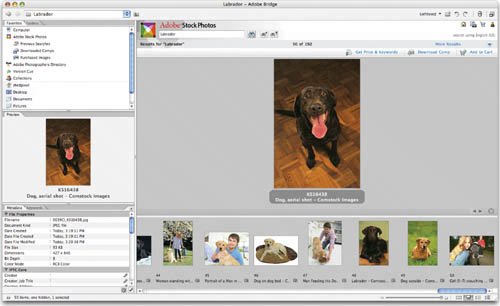| Professionals find it is often necessary to purchase images to complete their projects. Whether it's a shot of broccoli for a magazine layout, or the New York skyline for the cover of a DVD, stock photo services can help. But finding the right stock photo service is a balancing act. You must consider several factors when making a choice. Cost: There is a lot of competition out there, and photos are priced accordingly. Some services offer annual subscriptions, others charge per image. Be sure to keep your budget in mind when searching for needed photos. Resolution: Sites often charge more for higher-resolution images. Be sure to know how you'll use the image; Web site designers will pay less for an image than someone designing an annual report. That's because a Web image is lower resolution, while the report will be professionally printed and require higher-resolution images. Exclusivity: Does the image need to be yours and yours alone? Or is it OK that you might see the photo in someone else's project? Images that have their usage rights-managed cost more. A rights-managed image has restrictions placed on who can use the image for a certain time period. In contrast, a royalty-free image is purchased once and can be used as many times as the designer wishes. Quality: Expensive doesn't guarantee "better," but it does increase your chances. More expensive sites often have a better selection and image choices (the best photographers charge more, go figure). If you are on a budget, prepare to spend more time searching. There's a line often used in the professional creative community: "Good, Fast, Cheap... pick two." Seems appropriate here as well.
Royalty-Free does not Equal Free Do not confuse royalty-free and free. A royalty-free image must still be purchased. This is how the photographer and distributor make money. Royalty-free images can be a big savings as you can eliminate model releases, talent charges, location fees, travel, and many other costs associated with a photo shoot. However, someone had to pay those charges in the first place, and selling their pictures is their livelihood. Remember to pay for what you use. It's the professionally responsible way, as well as the law. |
Finding Stock Photos with Adobe Bridge Starting with Photoshop CS2, a stock photo browser is built into Photoshop (via Bridge, the file browser). Please note: These images are targeted at professionals, and are often expensive. 1. | Choose File > Browse to access Bridge.
| 2. | Click the Adobe Stock Photo link under Favorites.
| 3. | In the search field, type a keyword to search. Press return.
| 4. | The corresponding images will load. You can then choose to Get Price & Keywords, download a Comp Image (low-quality preview) to show your client, or Add to Cart to purchase.
|
Tip: Don't Pay Twice Here are two cost-saving tips when it comes to purchasing stock images. If downloading images, be sure to back them up to CDs or DVDs. Most stock image sources allow you to make a backup copy for your own use. If you are a student, check with your school library. Many have memberships to online image services. Your tuition or tax dollars have paid for these images, just be sure to check out any restrictions you may have.
 The Fair-Use Myth A popular myth in academic cultures is fair use. The doctrine provides situations where copyright works can be used without paying. It places restrictions on: The purpose and character of the use, including whether such use is of a commercial nature or is for nonprofit educational purposes; The nature of the copyrighted work; The amount and substantiality of the portion used in relation to the copyrighted work as a whole; and The effect of the use upon the potential market for or value of the copyrighted work.
For more on copyright and fair-use doctrine, visit www.copyright.gov.  Students and teachers alike get caught up in exemption number one. It is true that in a classroom situation, you can use virtually any image you want for practice or class exercises. However, here is the problem: As soon as a student wants to start looking for a job and builds a portfolio, those images are being used for financial gain. If you are a student, you need to build work samples that help you get a job. Use images that you have the rights to (or have photographed yourself). The other clause that is often seen as a loophole is number four. People often think that because their project was "small" or "personal" that damage cannot be claimed. It is relatively easy for a copyright holder to claim damages or lost revenue. While they may not go after you, why take the chance? As a content creator, you should respect the law and the welfare of your fellow designers and photographers. |
Finding Stock Photos Online Another way to find stock images is to turn to the power of the Internet. There are several sites available to choose from. Here are some that offer high-quality images. Be sure to compare prices and usage rights to ensure they work for your project. istockphoto: (pay per image) www.istockphoto.com AbleStock: (subscription based) www.ablestock.com Photo Objects: (subscription based) www.photoobjects.net Photos.com: (subscription based) www.photos.com Comstock Images: (pay per image) www.comstock.com Thinkstock Images: (pay per image) www.thinkstock.com Stockbyte: (pay per image) www.stockbyte.com
|

